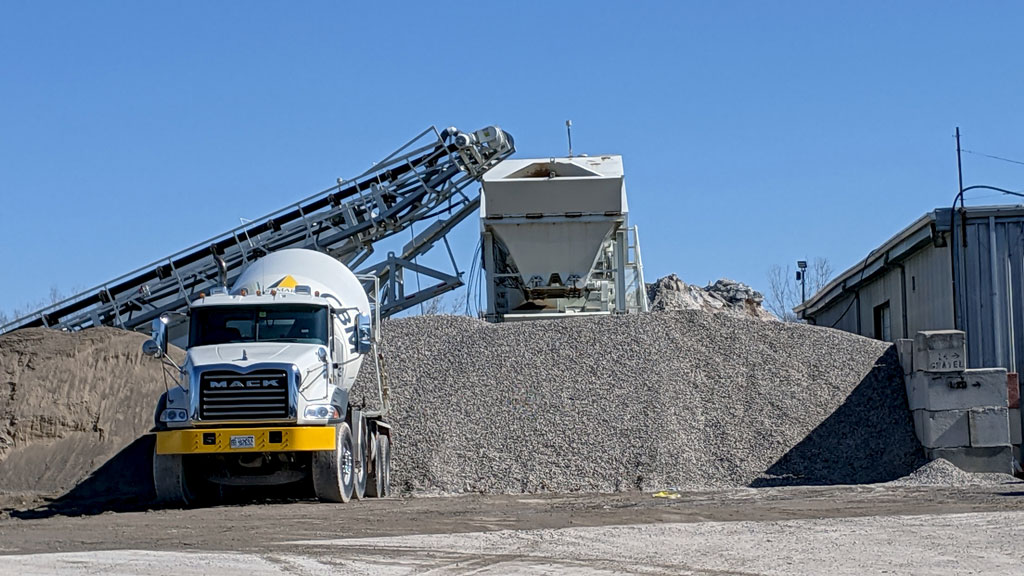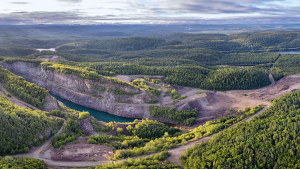Multiple Ontario construction projects are being threatened by protests at quarries by aggregate haulers who have parked their trucks looking for a major increase in rates.
The work action by the haulers started March 14 according to Jagroop Singh, the president of the Ontario Aggregate Trucking Association (OATA), and continued into a second week on March 21.
The disruption to the concrete supply chain prompted concerted action by representatives of nine construction associations including the Ontario General Contractors Association (OGCA), the Ontario Road Builders’ Association and Concrete Ontario on March 18 in the form of a letter addressed to Premier Doug Ford calling for “emergency industry consultation” on rising costs in general.
“This was the straw that broke the camel’s back,” said OGCA president Giovanni Cautillo. “We have been trying to deal with all of the issues on the supply chain the last few years and we’ve tried workaround suggestions and alternatives.
“This aggregate situation came upon us without any warning.”
Concrete Ontario president Bart Kanters sent a memo to the association’s members on March 16 pointing out that concrete is the most common construction material in the world, with 60 to 70 per cent made from local aggregates.
“Given the just-in-time delivery system used by our industry for aggregate deliveries and the limited amount of area to stockpile aggregates at the concrete plant, it is expected that a significant number of GTA concrete plants will not have sufficient aggregates to continue producing concrete,” the memo stated.
Kanters said he would not comment publicly but stated in an email, “I will confirm that there are significant supply chain issues as it relates to concrete aggregates and that our members are not able to supply projects in the GTA both last week and this week.”
Our rates are so poor, our rates are so bad, we can’t survive anymore. Inflation is really, really skyrocketing. We save nothing every day,
— Jagroop Singh
Ontario Aggregate Trucking Association
Cautillo said ICI projects are still predominantly constructed with concrete with pours a critical step early in the process.
“We are at a standstill,” he said. “And incidentally, our members are facing liquidated damages through contracts that are beyond their control, because it is a third-party implementation, this protest that causes and affects our members directly.”
Aggregate is hauled from quarries to concrete plants where ready-mix concrete is produced to be transported by concrete trucks to jobsites. Singh explained that OATA members work piecemeal or by contract hauling aggregate between quarries and concrete producers.
Rates have not changed for many years, Singh said, adding his association sent a letter to the producers a month ago describing how rising costs are hurting his members and asking for a 40-per-cent hike in rates.
“They ignored us,” said Singh.
“It’s very simple. We want an increase of our rates. Our rates are so poor, our rates are so bad, we can’t survive anymore. Inflation is really, really skyrocketing. We save nothing every day.
“So it makes sense, instead of rolling we should stop.”
Every aspect of the haulers’ business is more costly, Singh explained, including diesel, tires and more.
Petroleum analyst Dan McTeague commented that rising diesel costs have severely impacted the construction sector.
“Diesel is a big concern in terms of price, which has doubled year over year,” he said.
Singh said almost all OATA members are participating in the work stoppage. About 25 aggregate sites are being picketed involving over 200 drivers, he said.
There has been no movement on the part of the producers during discussions, Singh said.
Cautillo said, “For them to come to us and say, ‘You must give us all a price increase,’ I find their actions and their activities to be not only disruptive but disheartening to the greater good of construction, especially on the heels of us coming out of COVID.”
The memo from Concrete Ontario, formerly the Ready Mix Concrete Association of Ontario, stated that representatives from both the aggregate and concrete industry are working to address the issues that have been raised.
“We wish to encourage calm and constructive dialogue by all parties,” stated Kanters in the memo. “That being said, the current blocking of the delivery of aggregates is extremely harmful to the aggregate producers, the aggregate haulers, the ready-mixed concrete producers and the large number of construction projects that require concrete on a daily basis.”
The message from the construction associations to the Ontario government stated, “There exists serious risk to public infrastructure and associated economic development in Ontario if mitigation measures are not introduced.”
The stakeholders cited as an example of possible mitigation the implementation of a regulation requiring indexing of key inputs to occur after certain high cost thresholds are reached.
Cautillo said representatives of the nine associations would be meeting late March 21 to discuss further strategy.
Follow the author on Twitter @DonWall_DCN.










The author is confused in his terminology. It isn’t a cement plant it’s a concrete plant and they put product into concrete trucks not cement trucks. Cement is a powder that is part of the overall recipe for concrete. It’s the flour to a recipe of for bread. Thank you